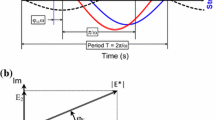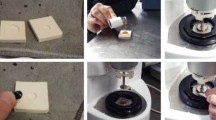Abstract
As bituminous materials are viscoelastic in nature, their performance must be characterised using test methods and analytical techniques that account for time (or rate) of loading and temperature. In addition, it is usually advisable to confine the characterisation of a bitumen to its linear viscoelastic response (small strains) to simplify the mathematical modelling of the material, as non-linear response, particularly for viscoelastic materials, is extremely difficult to characterise in the laboratory and model in practical engineering problems. This paper describes an investigation of the linearity limits of a range of unmodified and modified bituminous binders and mixtures using a dynamic shear rheometer and a purpose-built dynamic, direct tension-compression, servo-hydraulic testing apparatus. The results show that there are strain dependent linearity criteria for both binders and asphalt mixtures at high stiffness values (low temperatures for binders and low to intermediate temperatures for mixtures) as well as a high temperature strain dependent linearity criterion for elastomeric modified binders. The linearity strain criterion for the mixtures was found to be in the order of 100 microstrain with the criterion for the binders being at least 100 times greater at just over 10,000 microstrain and the polymer network strain criterion at 1,000,000 microstrain.
Résumé
Étant donné que les matériaux bitumineux sont naturellement viscoélastiques, la caractérisation de leur tenue en service doit faire appel à des méthodes expérimentales et des techniques analytiques qui tiennent compte du temps (ou de la vitesse) de chargement et de la température. En outre, il est généralement recommandé de se baser sur la réponse viscoélastique linéaire (petites déformations) dans la caractérisation du bitume. Ceci permet de simplifier la modélisation mathématique du comportement matériel, vu que la réponse non linéaire des matériauxviscoélastiques est difficile à caractériser expérimentalement et à modéliser dans le cas des problèmes pratiques de l’ingénieur. Cet article décrit une étude des limites de linéarité concernant une gamme de liants et mélanges bitumineux non modifiés et modifiés, à l’aide d’un rhéomètre de cisaillement dynamique et d’une machine à commande hydraulique, conçue en vue d’effectuer des essais dynamiques de tension-compression directe. Les résultats montrent que des critères de linéarité dépendant de la déformation existent aussi bien pour les liants que pour les mélanges bitumineux, pour des valeurs élevées de la rigidité, à de basses températures pour les liants et à des températures basses ou intermédiaires pour les mélanges. Dans le cas des liants élastomères modifiés, un critère de linéarité dépendant de la déformation à haute température est également mis en évidence. Le critère de linéarité dépendant de la déformation pour les mélanges s’est avéré de l’ordre de 100 micro-déformation. Le critère correspondant aux liants étant au moins 100 fois supérieur et dépasse les 10000 micro-déformation et celui du réseau de polymère se situe à 1000000 micro-déformation.
Similar content being viewed by others
References
Van der Poel, C., ‘A general system describing the viscoelastic properties of bitumen and its relation to routine test data’,Journal of Applied Chemistry 4 (1954) 221–236.
Ferry, J.D., ‘Viscoelastic Properties of Polymers’, 3rd Ed. (John Wiley & Sons, New York, 1980).
Bahia, H.U., Hislop, W.P., Zhai, H. and Rangel, A., ‘Classification of asphalt binders into simple and complex binders’,Journal of the Association of Asphalt Paving Technologists 67 (1998) 1–41.
Airey, G.D., Rahimzadeh, B. and Collop, A.C., ‘Linear viscoelastic limits of bituminous binders’,Journal of the Association of Asphalt Paving Technologists 71 (2002).
Anderson, D.A.et al., ‘Binder Characterisation, Vol. 3: Physical Properties’, SHRP-A-369, Strategic Highways Research Program, Nat. Research Council, Washington, D.C., 1994.
Airey, G.D., Rahimzadeh, B. and Collop, A.C., ‘Linear and nonlinear rheological properties of asphalt mixtures’, Proceedings of the 4th Europ. Sympos. on Performance of Bitum. and Hydraulic Materials in Pavements, Nottingham, 2002, 137–145.
British Standards Institution, ‘Penetration of Bituminous Materials’, BS 2000: Part 49, 1983.
British Stan. Inst., ‘Softening Point of Bitumen (Ring and Ball)’, BS 2000: Part58, 1983.
Am. Soc. for Testing and Mater., ‘Standard test method for effect of heat and air on a moving film of asphalt (rolling thin film oven test)’, ASTM D2872-88, Philadelphia, USA, 1995.
British Stan. Inst., ‘Coated Macadams for Roads and Other Paved Areas’, BS4987: Part 1, 1993.
British Stan. Inst., ‘Hot Rolled Asphalt for Roads and Other Paved Areas’, BS594: Part 1, 1985.
Airey, G.D., Hunter, A.E. and Rahimzadeh, B., ‘The influence of geometry and sample preparation on dynamic shear rheometer testing’, Proc. of the 4th Europ. Symp. on Performance of Bitum. and Hydraulic Materials in Pavements, Nottingham, 2002, 3–12.
Bahia, H.U., Zhai, H., Bonnetti, K. and Kose, S., ‘Non-linear viscoelastic and fatigue properties of asphalt binders’,J. of the Ass. of Asphalt Pav. Techn. 68 (1999) 1–34.
Cheung, C.Y. and Cebon, D., ‘Experimental study of pure bitumens in tension, compression and shear’,J. of Rheology (1997) 45–73.
Author information
Authors and Affiliations
Additional information
Editorial Note: Presented at the 6th International RILEM Symposium on Performance Testing and Evaluation of Bituminous Materials (PTEBM’03), held on 14th–16th April 2003, in Zurich, Switzerland, this paper was selected as an outstanding communication and peer-reviewed by the Scientific Committee of the Journal Materials and Structures Dr. Andrew C. Collop works at the University of Nottingham, a RILEM Associate Member, and participates in RILEM TC 182-PEB ‘Performance testing and evaluation of bituminous materials’.
Rights and permissions
About this article
Cite this article
Airey, G.D., Rahimzadeh, B. & Collop, A.C. Viscoelastic linearity limits for bituminous materials. Mat. Struct. 36, 643–647 (2003). https://doi.org/10.1007/BF02479495
Issue Date:
DOI: https://doi.org/10.1007/BF02479495




